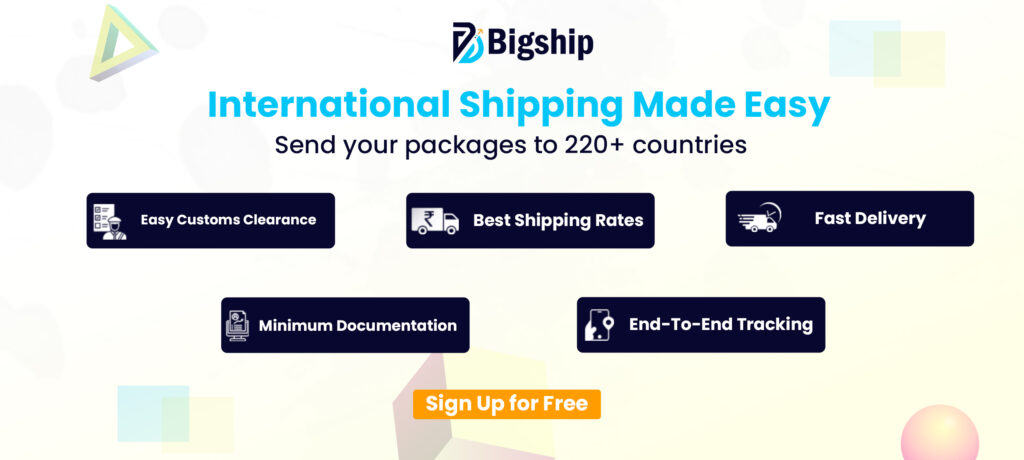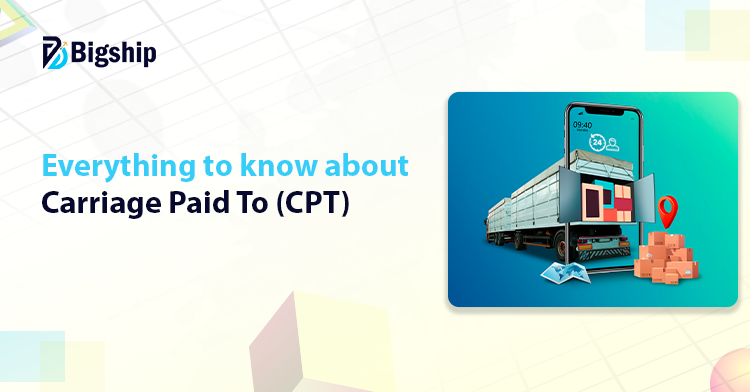Shipping terms can get confusing, especially when you’re dealing with global trade. If you’re trying to figure out what is carriage paid to, you’re not alone. Many buyers and sellers want clarity on who pays for what, and who takes the risk.

Carried Paid To or CPT is an international trade term or incoterm help you answer the above questions. Once you know how CPT works, it becomes easier to plan your shipments without surprises. In this blog, you’ll learn everything about CPT in a way that’s easy, clear, and straight to the point.
What is Carriage Paid To (CPT)?
Carriage Paid To or CPT incoterm means the seller pays to deliver the goods to a carrier at an agreed place. The cost and responsibility stay with the seller until the goods reach that point. Once the carrier receives them, the risk shifts from them to the other party. This carrier could be handling the goods by road, rail, air, or sea.
The seller handles export clearance, hires the carrier, and pays transport costs up to the handover point. If anything goes wrong before the goods reach the carrier, it’s the seller’s responsibility. After that, they are not responsible for any loss or damage.
Some charges like Terminal Handling Charges (THC) may be included in the CPT price. It’s always better to check this in the deal. So, in CPT, the seller pays till the goods reach the carrier.
Example of Carriage Paid to (CPT)
Let’s say you are buying electronic parts from a seller in Germany, and you are based in Mumbai. You both agree to use Carriage Paid To. The seller promises to deliver the goods to a carrier at Frankfurt Airport. The cost of shipping, export duties, and customs paperwork in Germany will be paid by the seller. But once the goods are handed over to the airline in Frankfurt, the risk shifts to you.
Suppose, while the goods are being taken by truck from the seller’s warehouse to the airport, the truck meets with an accident and the cargo gets damaged. If the goods had already been officially handed over to the trucking company (the first carrier), then the seller is no longer responsible. Since you agreed to CPT terms, the risk passed to you at that point. If you didn’t insure the goods, the loss is yours.
Under CPT terms, the seller is not bound to choose the safest or most expensive transport. They only need to ensure the goods reach the carrier. Also, in CPT, the seller might not always deliver to your final location. You both can agree on a midway point. Maybe you know a local carrier in India who offers better rates, so you ask the seller to ship only till Delhi. That’s allowed under CPT as long as you both agree.
What are the seller’s responsibilities under CPT?
Under Carriage Paid To or CPT terms, the seller has several key responsibilities before the goods are handed over to the first carrier. Let’s go through each of these duties one by one.
Packaging: The seller must pack the goods properly for international transportation. The packaging should protect the items throughout the journey. It must match the type of product and the transport method being used. For example, fragile items need extra care, and moisture-sensitive goods need waterproof packaging.
Loading Fees: The seller has to cover the cost of loading the goods onto the truck or vehicle that will take them to the carrier. This includes any labor or equipment charges at the seller’s warehouse or factory.
Delivery to Agreed Location: It is the seller’s duty to move the goods from their location to the port or another place where the goods will be handed over to the carrier. The seller can choose a transport company or use platforms like Bigship to find a trusted delivery service.
Origin Terminal Handling Charges: The seller has to pay charges at the origin terminal. These are the fees collected by the terminal for handling the goods before they are loaded onto the main transport. It includes moving, checking, and preparing the goods for the next step.
Loading on the Main Carrier: Once the goods reach the port or airport, the seller also handles the loading onto the main transport, such as a ship or plane. They must pay any loading fees and make sure the goods are loaded correctly. If anything goes wrong during this step before handover, the seller is responsible for the damage.
Freight Charges: The seller must pay for the freight, which is the cost to move the goods to the destination agreed upon with the buyer.
Destination Terminal Handling Charges: Even after the goods reach the destination, the seller has to take care of some costs. Destination Terminal Handling Charges are the fees charged at the terminal in the buyer’s country. These charges cover the handling of the goods once they arrive.
What are the buyer’s responsibilities under CPT?
In a CPT agreement, the seller takes care of the goods only until they are handed over to the first carrier. After that, it becomes your responsibility as the buyer to make sure the goods reach you safely. The responsibilities of the buyer are mentioned below.
Insurance: Buyer must take care of insurance after the seller hands over the goods to the carrier. If the goods are lost or damaged during transit, the loss will be of the buyer unless they have insurance.
Transport to final destination: When the goods arrive at the port or airport in the destination country, it’s the buyer’s job to arrange their journey to the warehouse or final address.
Unloading the goods: Once the goods reach the destination, the buyer will need to handle unloading. This includes hiring workers or a local service to unload the shipment.
Customs, Import Duties, and Taxes: Buyer must clear the goods through customs in the destination country. This means paying import duties, taxes, and following local rules. Buyer should know what taxes apply to the products and be ready with the paperwork.
Benefits and Drawbacks of Carriage Paid To
Carriage Paid To or CPT have both benefits and drawbacks. These depend on whether you are buying or selling. Let’s look at the pros and cons in a clear and simple way.
Advantages of Carriage Paid To
- Seller pays for transport to the first carrier,thus, reducing cost and risk for the buyer.
- Buyer does not need to manage export paperwork or arrange export clearance.
- Seller handles export taxes, customs, and legal formalities at the origin.
- Makes it easier for the buyer to place an order, especially if the seller is in a different country.
- Helps sellers close more deals by offering a more secure and buyer-friendly shipping option.
Disadvantages of Carriage Paid To
- Seller carries the risk and cost until the goods reach the first carrier.
- If the goods are damaged before reaching the carrier, the seller is responsible.
- Buyer takes on the risk once the goods are handed to the first carrier, even if it’s just a truck to the port.
- Buyer must handle customs clearance, taxes, and delivery after the goods reach the destination.
- If the shipment involves multiple modes of transport, tracking and managing risk becomes more complex for the buyer.
Difference between CPT and CIF in shipping
Both CPT and CIF are part of international trade rules, but they apply in different ways. Here’s a simple comparison between both terms.
| CPT | CIF |
| The full form of CPT in commerce is Carriage Paid To. | CIF’s full form is Cost, Insurance, and Freight. |
| It is applied to all modes of transport, including land, air, or sea. | It applies only to maritime shipping. |
| The responsibility of the seller ends once goods are handed over to the first carrier. | Seller’s responsibility ends when goods are loaded onto the shipping vessel. |
| In CPT, the buyer arranges insurance after handover. | Here the seller provides insurance until goods are on the ship. |
Conclusion
Carriage Paid To or CPT makes global trade clear for both buyers and sellers. Once the goods are with the first carrier, the seller’s job ends, and the buyer takes over. It sets clear rules for cost and risk.
If you now understand what is carriage paid to, using CPT Incoterms in your deals will feel simpler. It helps both sides know what to expect at each step. Always read the terms before you agree, so there are no surprises later.
FAQs
What is Carriage Paid To in simple words?
Carriage Paid To means the seller pays to deliver goods to a carrier at an agreed place. After that, the risk and responsibility shift to the buyer.
What is the risk transfer point in CPT?
The risk moves from the seller to the buyer once the goods are handed over to the first carrier, not at the final destination.
Is CPT used only for sea transport?
No, CPT is not limited to sea shipping. It applies to road, rail, air, sea, or even mixed transport.
What is the buyer’s role under CPT terms?
The buyer must arrange insurance, manage import customs, pay duties, and handle local delivery after the goods reach the first carrier.





